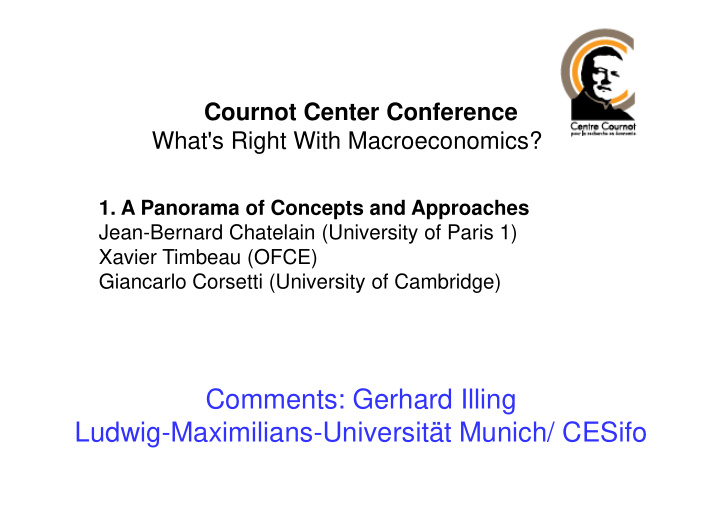



Cournot Center Conference What's Right With Macroeconomics? 1. A Panorama of Concepts and Approaches Jean-Bernard Chatelain (University of Paris 1) Xavier Timbeau (OFCE) Xavier Timbeau (OFCE) Giancarlo Corsetti (University of Cambridge) Comments: Gerhard Illing Ludwig-Maximilians-Universität Munich/ CESifo
CESifo Economic Studies Conference Nov 2009 What's Wrong With Modern Macroeconomics? Michael Wickens: � Modern macroeconomics has received a huge stimulus � The financial crisis was brought about more by a failure to employ modern macroeconomics than by the failings of employ modern macroeconomics than by the failings of macroeconomics. My View: � Modern macro is just an abstract language � We have all the tools needed to include models of „financial crises“ But: It was not done until recently
Before the crisis � Mainstream View: New Keynesian Paradigm - DSGE Model � Monetary Policy Rule (Taylor Rule) Monetary Policy should aim to stabilize inflation (and output) around low level (below, close to 2%) (Inflation [Forecast?] Targeting) No specific need to target asset prices � Great Moderation (partly due to better policy) � Limited scope for countercyclical fiscal policy
Challenges after the crisis � „Is this time really different?“ Rogoff/Reinhart (2010) → New Paradigm � Or let‘s go back to neoclassical repair shop to build next generation of synthesis models? (Re-)Introduce Financial Intermediation (Re-)Introduce Financial Intermediation (Re-)Introduce Multiple Equilibria (Bifurcations); Self fulfilling Traps Key ingredients of models of financial crises (financial crises models: Generation 1, 2, 3, 4) Calvo 1988 Servicing Public Debt Multiple equilibria with zero bound/ Liquidity Trap Benhabib/Schmitt Grohe/Uribe AER 2001
Real puzzle: � Why did we not take these insights seriously? � Examples : � Fiscal policy may be extremely powerful in a liquidity trap (Eggertson; Christiano/Eichenbaum; Corsetti et. al. Fiscal Stimulus with Spending Reversals) � Ricardo equivalence not relevant for countercyclical policy � Asset Price Misaligments (Boom/Bust Cycles) Models of limits of arbitrage Risk of fire sales (due to high leverage) → Need for regulation of financial markets (Hyun Shin, Brunnermeier/Pederson)
My presentation at Centre Cournot on 1. December 2006 Financial Stability and Monetary Policy – A Framework Summary: � High social cost of fire sales: → → → → Commitment not to intervene is not credible � Challenge: Prevent building up of imbalances by stronger dampening of shocks during the boom period dampening of shocks during the boom period � → → → Trade off between efficient stabilisation and → prevention of financial imbalances � Superior approach compared to commitment not to intervene: Use additional instruments to tackle the underlying problem (such as regulation of liquidity holding)
Complacency before the financial crisis � Successful handling of past crises: � 1987 Crash; LTCM crisis 1998; Crash of Internet Bubble 2001 → Overconfidence in policy; at the same time: Belief in benefits of deregulation; Panglossian view: wonderful free market world
Jean-Bernard Chatelain/ Xavier Timbeau Excellent summary of current challenges No need to discard models with rational agents (no need to „reject“ No Ponzi Game condition; consumption smoothing etc.) Crisis can be explained as result of individually rational Crisis can be explained as result of individually rational behaviour resulting in aggregate failure (creating negative externalities) Richer modelling structure with heterogenous agents generate key features: Credit constrained agents; role of pro-cyclical leverage in amplifying shocks Heterogenous agent models: Distributional issues play key role
Giancarlo Corsetti � Timing Fiscal Retrenchment in the Wake of Deep Recessions Ben S. Bernanke, Rebalancing the Global Recovery, Frankfurt November 19, 2010 „However, in general terms, a fiscal program that combines near-term measures to enhance growth with strong, near-term measures to enhance growth with strong, confidence-inducing steps to reduce longer-term structural deficits would be an important complement to the policies of the Federal Reserve.“ Corsetti et. al. Fiscal Stimulus with Spending Reversals � NYT November 29, 2010 Amid Deficit Fears, Obama Freezes Pay Corsetti et. al. at Centre Cournot?
Corsetti New Keynesian DSGE model, hitting zero lower bound Standard monetary policy impotent Liquidity trap → Paradox of thrift Fiscal Policy very powerful (upward sloping AD curve) Message: With perfect credibility, Bernanke strategy is optimal Combine short term fiscal stimulus with long run Combine short term fiscal stimulus with long run consolidation Saint Augustine (354-435) Oh Lord , give me chastity, but do not give it yet. Problem: Lack of credibility Bond Vigilants get nervous: ask for high risk premium Multiple, self-fulfilling equilibria path
Problem: Risk premia are introduced ad hoc; not really endogenous How rational are your Bond Vigilants?
Diligent Bond Vigilants?
Diligent Bond Vigilants?
Debt/GDP ratio Greece, OECD data High Debt/GDP ratio in Greece was public information
Debt/GDP ratio UK 1692-2010
Debt/GDP ratio USA 1792-2010
Problem: Risk premia are introduced ad hoc; not really endogenous How rational are your Bond Vigilants? Optimal Strategy in your model: „A fiscal program that combines near-term measures to enhance growth with strong, confidence-inducing steps to reduce longer-term structural deficits“ (Ben Bernanke) Crucial: Long tem commitment Fiscal Austerity today will be counter-productive if it increases probability Fiscal Austerity today will be counter-productive if it increases probability for policy reversal (change in government) Key challenge: How to establish long term credibility? Raising retirement age; tackle health care cost Endogenize risk premia → Multiple equilibria prevailing (Calvo) Role of confidence crucial for policy design of adequate institutions DSGE model not helpful for addressing these issues!
Recommend
More recommend